Types of orchids – 10 stunning varieties for your home
Discover a rich tapestry of shapes and colors to enhance your plant collection
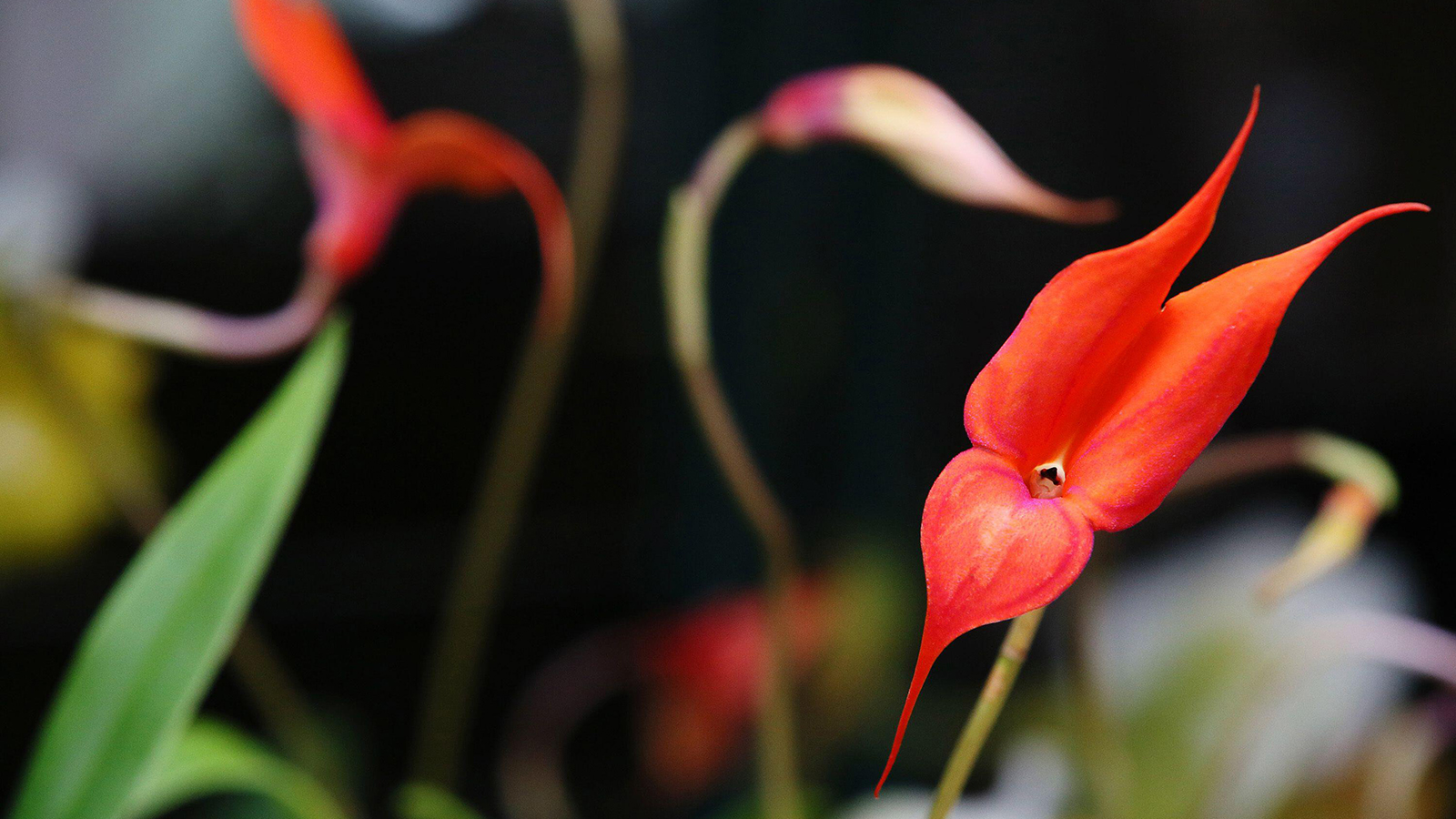

The orchid has to be one of the most beautiful flowering houseplants you can own. These lush-looking blooms are the perfect way to add a touch of the exotic to your interior scheme.
Orchids belong to one of the largest families of flowering plants, a diverse group that runs to 28,000 different types. They are found pretty much everywhere in the world (apart from Antarctica) and come in all shapes and sizes.
'As one of the best indoor plants, they come in a huge range of shades from dramatic magenta and plummy purple, to lemon yellow and tangerine orange, as well as pure white,' says houseplant specialist, Sarah Wilson.
'Some have plain colored petals while others are splashed or speckled with contrasting hues,' Sarah tells us.
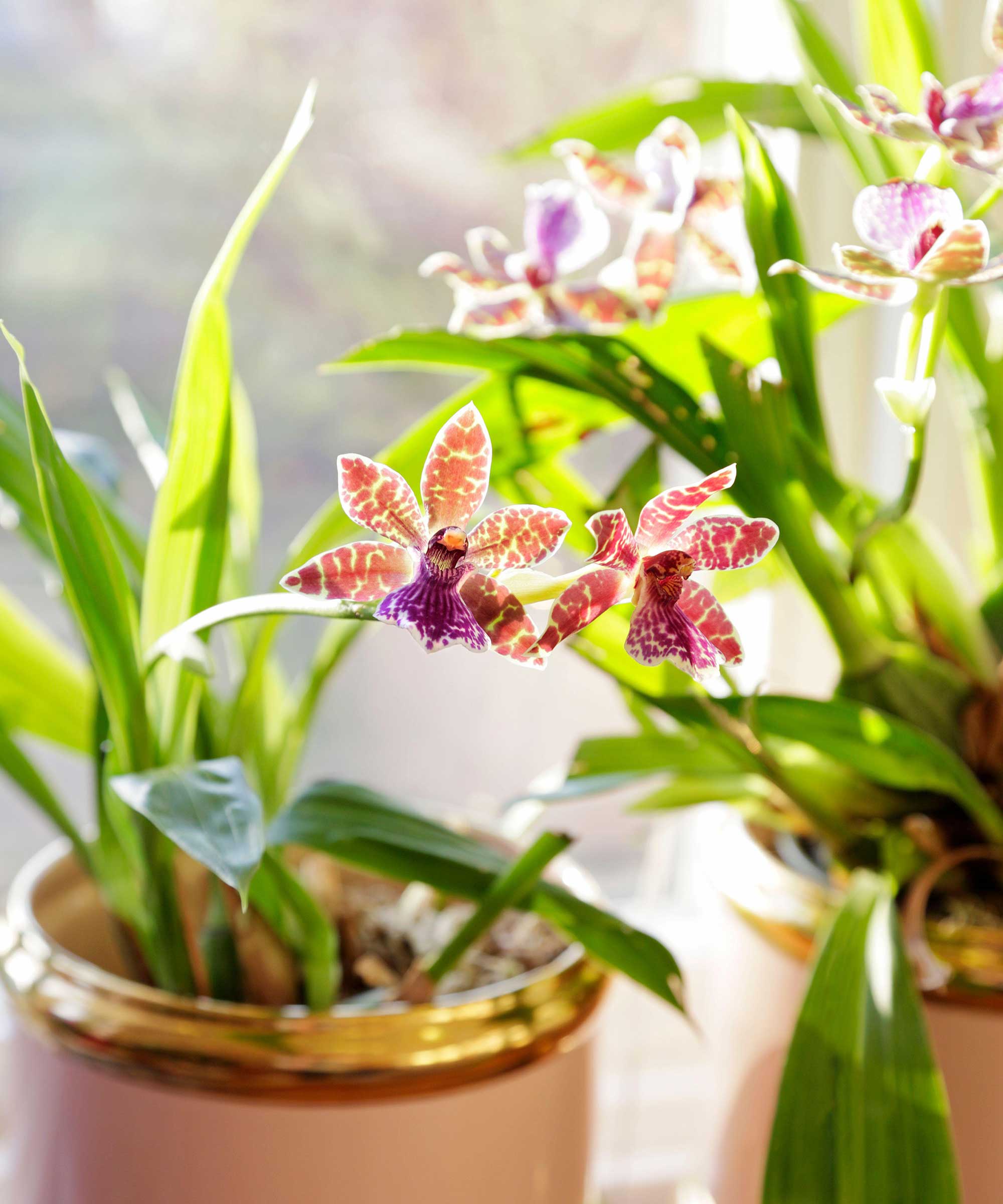
The Zygopetalum 'Adelaide Parklands' orchid
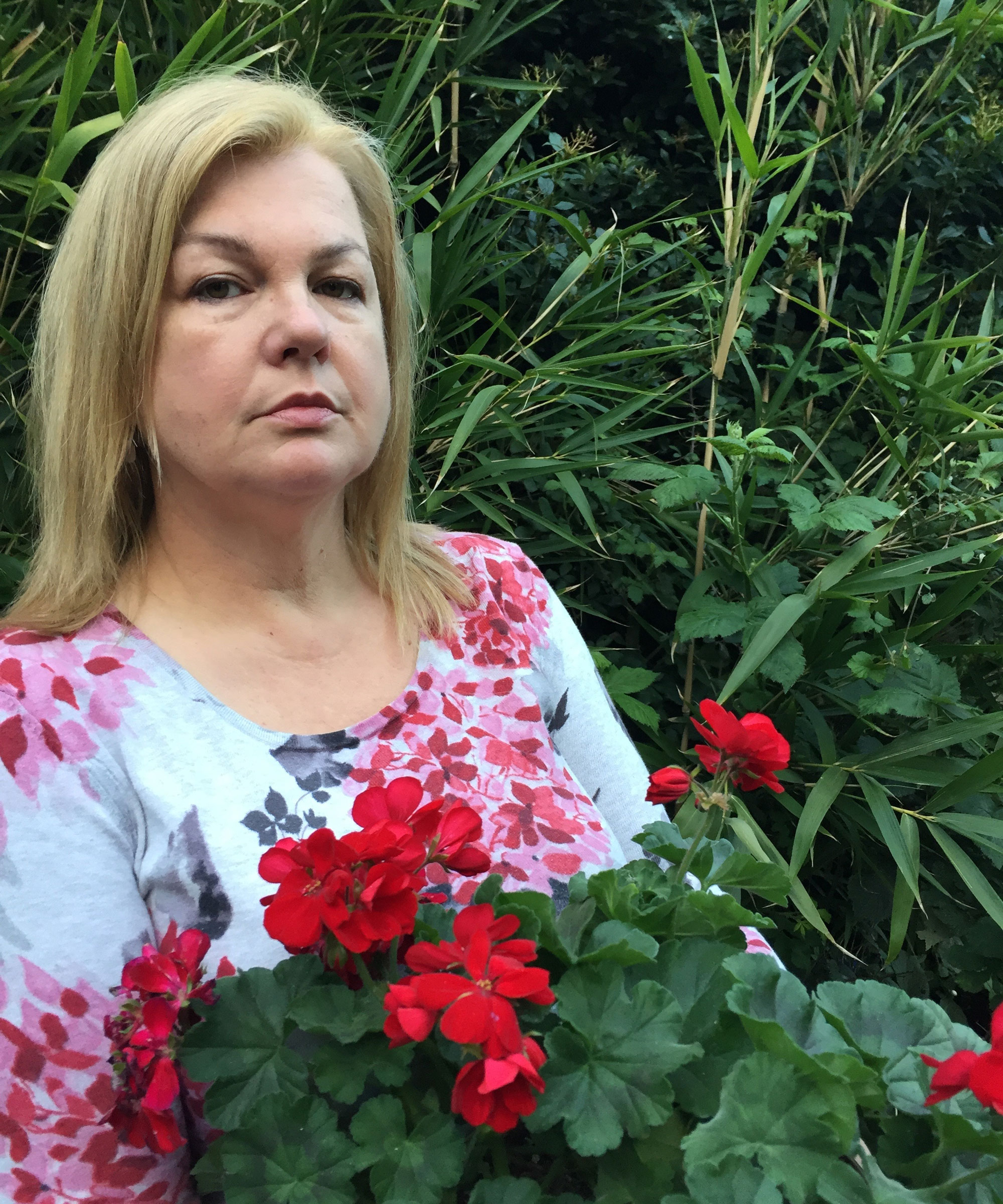
Sarah Wilson has been writing about flowers, plants, and garden design and trends since 2015. Having already studied introductory garden and landscape design as well as a course in floristry she is currently adding to her list of qualifications with an RHS Level 2 course in the Principles of Plant Growth and Development.
10 types of orchids to try
These stunning types of orchids will make long-lasting additions to your indoor garden. Some varieties are rarer than others, so it pays to keep your eyes open to spot your favorites when they come along.
1. Cymbidium

- Height and spread: 2ft
- Hardiness: USDA 11
- Min temp: 46-50°F
With their long narrow leaves and stems of voluptuous blooms, these classy fall-to-spring-flowering orchids would give any house a stately edge.
These orchids can grow outdoors in semi-shade for summer, but should come indoors to a cool position for winter and spring. Miniature types are more compact.
Design expertise in your inbox – from inspiring decorating ideas and beautiful celebrity homes to practical gardening advice and shopping round-ups.
You should try to repot orchids every few years to ensure they continue to flower.
2. Masdevallia veitchiana
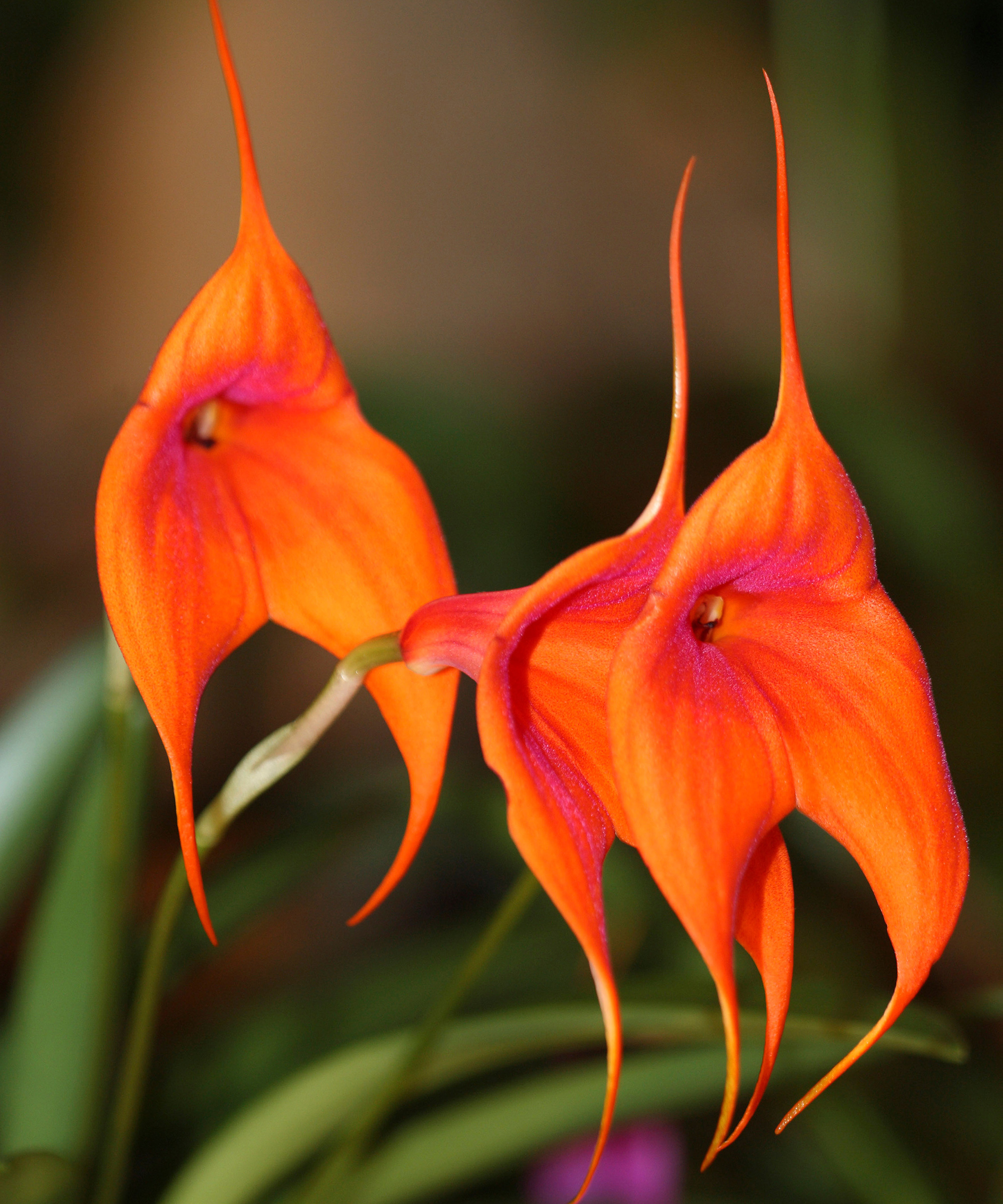
- Height and spread: 9in
- Hardiness: USDA 11
- Min temp: 50°F
In its Peruvian cloud forest home, this orchid is a lithophyte, meaning it grows on rocks.
How long do orchids bloom for? Well, this particular variety's short stems bear leaves, and in spring and summer sinister-looking orange flowers whose sepals end in tails, emerge.
These types of orchids can easily succumb to rotting by over-watering, so ensure they have plenty of drainage, are kept in a well-aired room, and watered sparingly in winter.
3. Miltonia Sunset

- Height: 18in
- Spread: 9in
- Hardiness: USDA 12
- Min temp: 55°F
This colorful pansy-orchid hybrid is easy to get hold of and a relatively low-maintenance indoor plant.
Elongated, mid-green pseudobulbs (organs which store water) and leaves are joined at random times of the year by stems of pansy-shaped flowers of festive purple-pink and yellow.
When repotting mature plants, it is easy to split them into smaller sections in order to propagate orchids.
4. Miltoniopsis
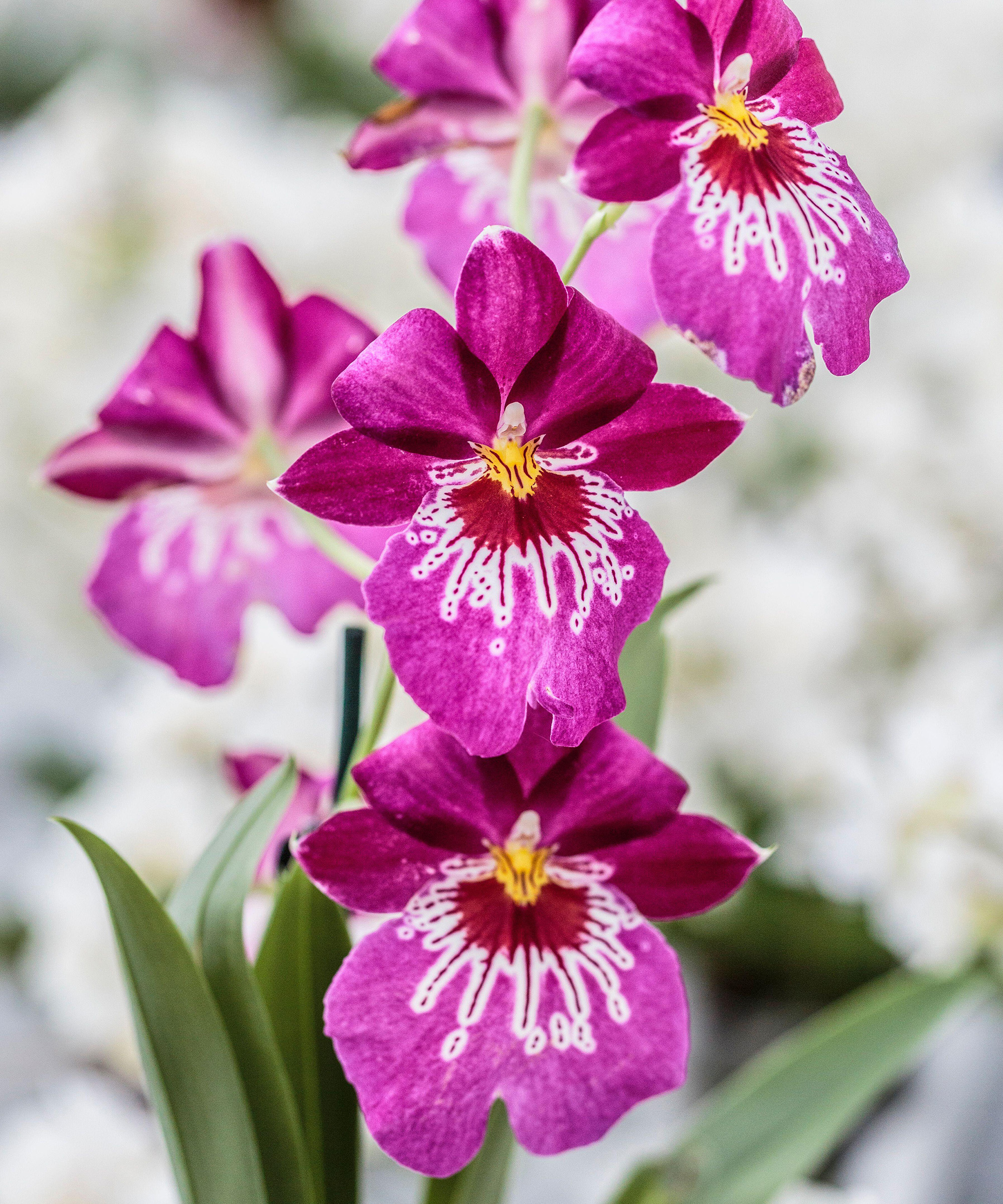
- Height and spread: 10in
- Hardiness: USDA 11-12
- Min temp: 52°F
The rounded, rather formless flowers of miltoniopsis are showier and more pansy-like than those of the miltonia orchid.
While the latter are mainly found in Brazil, miltoniopsis originate from Costa Rica and Venezuela. Their pseudobulbs are more rounded and produce gray-green leaves.
This variety enjoys a potting mix of fine bark, charcoal and perlite. You can buy Orchid Miltoniopsis Breathless 'Beauty' plants at Amazon.
5. Paphiopedilum
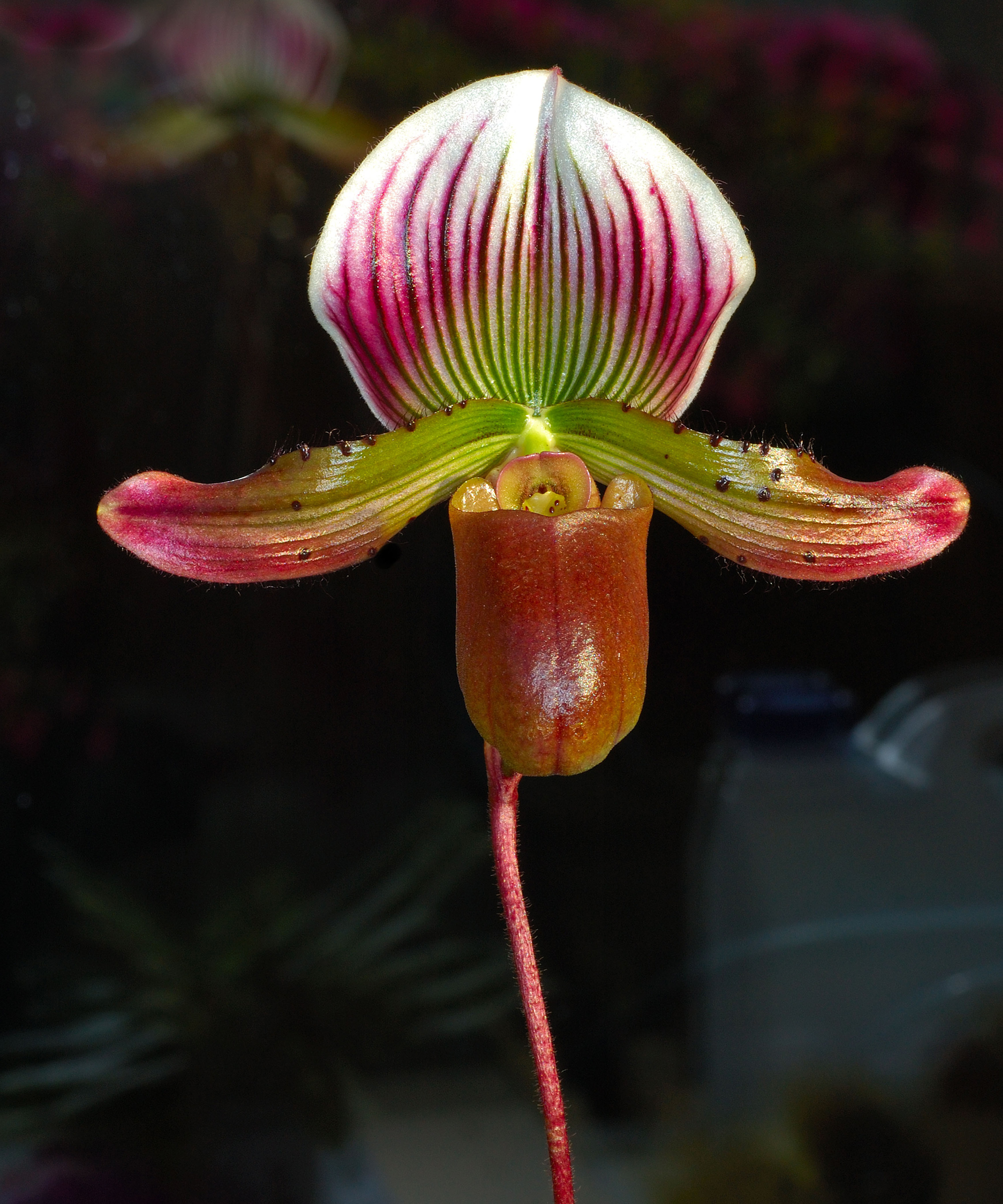
- Height: 12in
- Spread: 9in
- Hardiness: USDA 12
- Min temp: 55°F
Slipper orchids originate from India, China, parts of SE Asia and Papua New Guinea. Availability is somewhat random, so keep an eye open for plants.
The P. Mustache variety is famed for its striped upper sepal, long sweeping lateral sepals (the drooping mustache) and light brown pouch.
Be careful with how to water orchids of this variety, and be aware that it's easy to accidentally give too much to these houseplants as they have no pseudobulbs, which store water.
6. Phalaenopsis
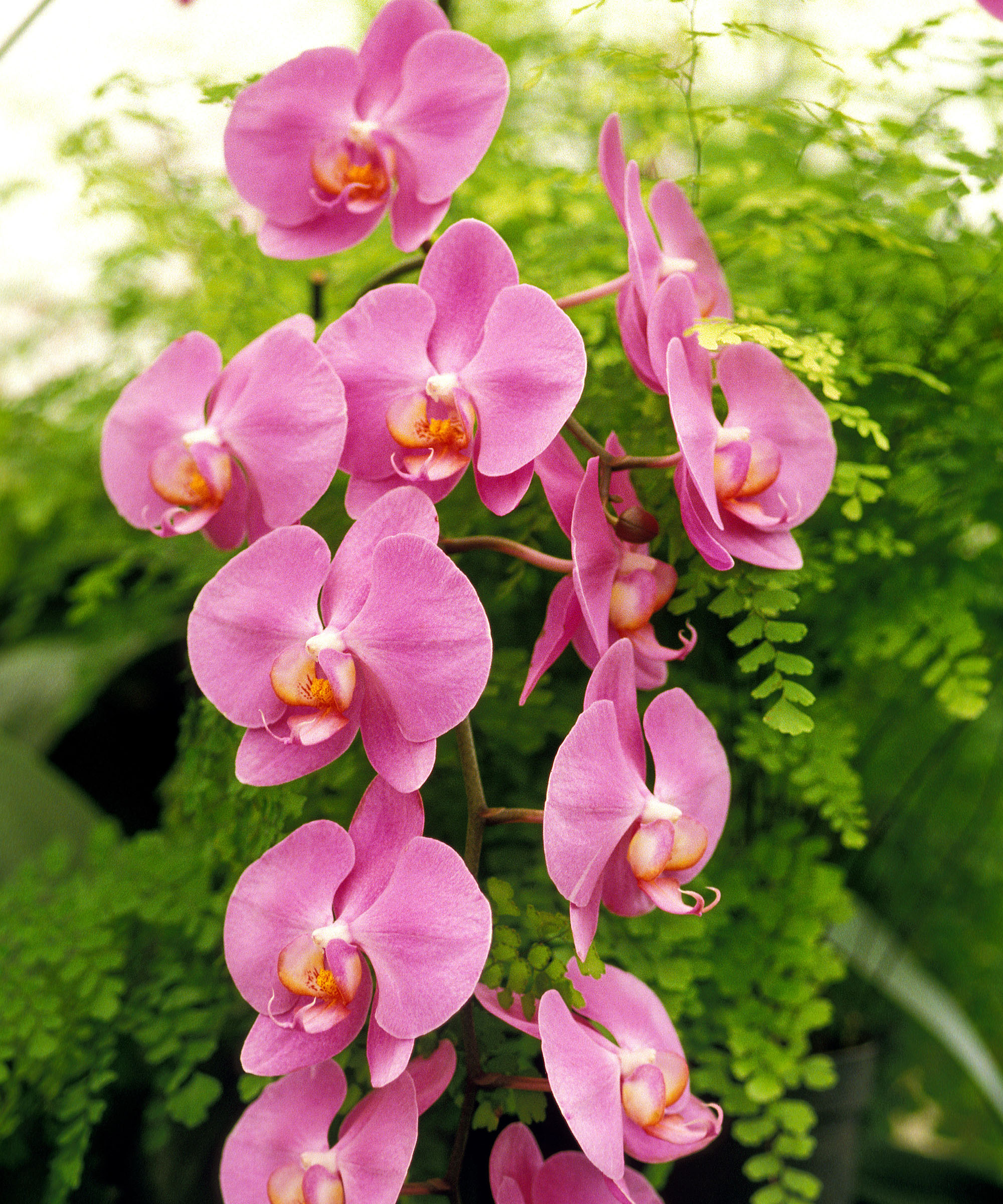
- Height: 18in
- Spread: 12in
- Hardiness: USDA 13
- Min temp: 60°F
These hybrids offer a variety of sizes and flower colors, from white to blue, on long-lived plants suited to good but not direct light in warm room conditions.
After flowering, prune orchids by cutting back the still-green flower spike to the first notch behind the last faded bloom – a side spike is often produced.
7. Vanda

- Height: 20in
- Spread: 12in
- Hardiness: USDA 12
- Min temp: 55-60°F
Among the most opulent of orchids, vandas originate from India, SE Asia and the Philippines. There are no pseudobulbs but plenty of thick aerial roots.
Historically grown in slatted baskets hung in shaded greenhouses, they are now often sold in open-sided pots sat in glass vases, periodically filled with water and then drained.
8. Zygopetalum
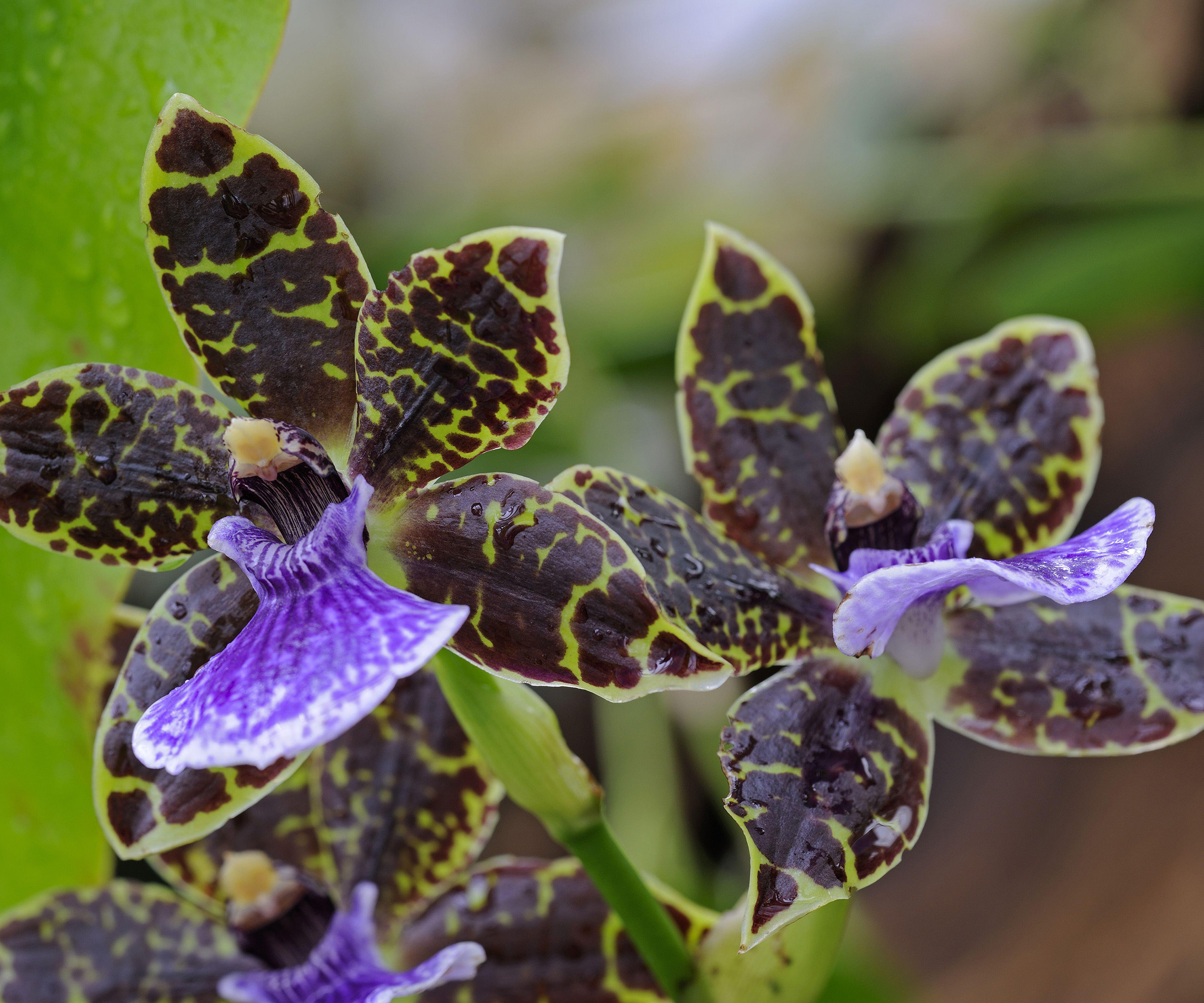
- Height: 12in
- Spread: 18in
- Hardiness: USDA 9-10
- Min temp: 52°F (11°C)
The warm, moist forests of South America are home to the parent species of these pseudobulb-forming orchids whose fragrant, richly-colored flowers open from fall to spring.
Upper sepals are generally lime-green and maroon, and the lower lips are indigo blue. Good, indirect light and cool nighttime temperatures are ideal.
9. Oncidopsis Nelly Isler
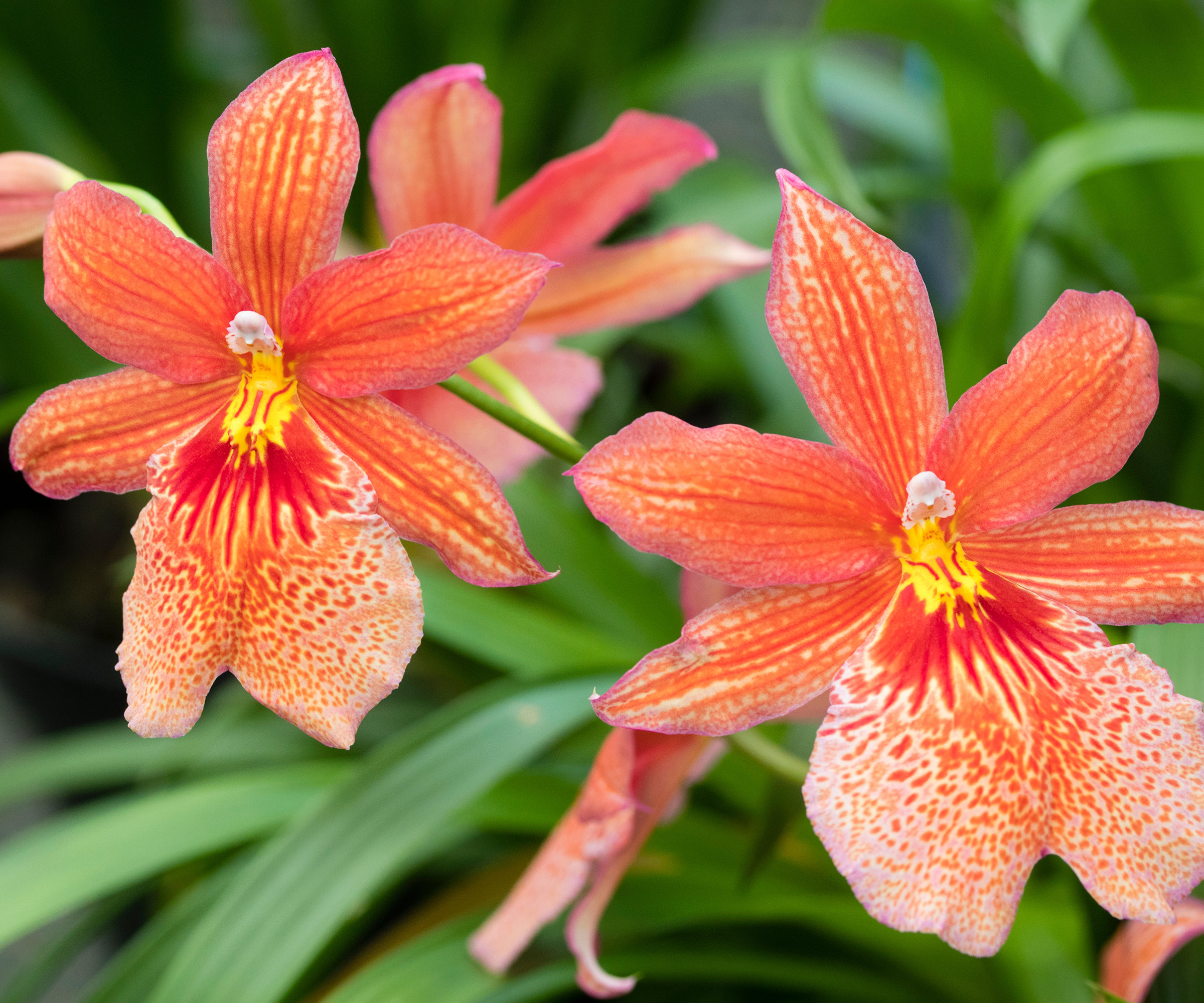
- Height: 10in
- Spread: 8in
- Hardiness: USDA 12
- Min temp: 50°F
A brightly colored, vigorous hybrid whose mature pseudobulbs produce two to three leaves each. The scented, long-lasting flowers are a warm carmine color with a paler, patterned lip marked yellow at the center.
Cooler winter temperatures help encourage these orchids to rebloom. Position them in filtered light to bring the best results.
10. Coelogyne cristata

- Height: 12in
- Spread: 2ft
- Hardiness: USDA 11
- Min temp: 50°F
There are several attractive species in this epiphytic genus. Coelogyne cristata is from the cool eastern Himalayas and is one of the best versions of this orchid variety.
It bears rounded pseudobulbs and, in winter, long dangling sprays of fragrant, yellow-throated white flowers with wavy petals. Cool, drier winters and regular summer watering are appreciated.
FAQs
How do I know which type of orchid I have?
'There are many apps to help you identify your orchid and you can look up varieties on the American Orchid Society Website ,' says Virginia Hayes, specialist at Westerlay Orchids.
'Since there are close to 30,000 different varieties of orchids, you can also identify your orchid by their roots, flower and leaves. The size, shape, and color of the blooms can help with identification, although it can be difficult to determine an orchid species based solely on these characteristics,' she says.
What's the best scented orchid?
'Many orchids such as the cattleya variety are heavily scented,' says houseplant expert Sarah Wilson.
'These have sumptuous frilled flowers too. Odontoglossum are also sweetly scented, with the added advantage that a single flower spike has as many as 20 blooms,' she says.
What are some types of orchid that can be grow directly outside?
'Cymbidium orchids thrive outside and can grow quite large,' says Virginia Hayes, specialist at Westerlay Orchids.
'You must still always keep the orchids in their pots and never plant them directly into the soil,' she says.

Virginia Hayes's floral background started in 1999 importing and exporting floral products from offices worldwide. She is an indoor plant pro, with a keen interest in floristry, and retail showroom manager at Westerlay Orchids.
The different types of orchids are almost endless. Orchids of all kinds will be a colorful floral addition to an indoor tropical plant collection.
Some of the more interesting varieties may be difficult to come by, however. It's worth going to specialist orchid suppliers if you want to find something a little more unique.

Having trained at Kew Gardens in London and worked in parks department nurseries and as Glasshouse Supervisor at RHS Wisley, Anne has been a freelance horticulturist since 1986. Anne writes for Amateur Gardening and has been a regular panelist on BBC Radio 4’s Gardeners’ Question Time for 27 years. A large plot full of wildlife habitats, edible and ornamental plants is Anne’s workshop and inspiration.